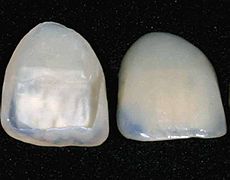- Veneer (dentistry)
-
Veneer (dentistry) Intervention
A veneerMeSH D003801 In dentistry, a veneer is a thin layer of restorative material placed over a tooth surface, either to improve the aesthetics of a tooth, or to protect a damaged tooth surface. There are two main types of material used to fabricate a veneer, composite and dental porcelain. A composite veneer may be directly placed (built-up in the mouth), or indirectly fabricated by a dental technician in a dental laboratory, and later bonded to the tooth, typically using a resin cement such as Panavia. In contrast, a porcelain veneer may only be indirectly fabricated.
Contents
History
Veneers were invented by a California dentist named Charles Pincus[1]. At the time, they fell off in a very short time as they were held on by denture adhesive. They were, however, useful for temporarily changing the appearance of actors' teeth.
Research started in 1982 by Simonsen and Calamia[2] revealed that porcelain could be etched with hydrofluoric acid, and bond strengths could be achieved between composite resins and porcelain that were predicted to be able to hold porcelain veneers on to the surface of a tooth permanently. This was confirmed by Calamia[3] in an article describing a technique for fabrication, and placement of Etched Bonded Porcelain Veneers using a refractory model technique and Horn[4] describing a platinum foil technique for veneer fabrication. Additional articles have proven the long-term reliability of this technique.[5][6][7][8][9][10][11][12][13]
Today, with improved cements and bonding agents, they typically last 10-30 years. They may have to be replaced in this time due to cracking, leaking, chipping, discoloration, decay, shrinkage of the gum line and damage from injury or tooth grinding. The cost of veneers can vary depending on the experience and location of the dentist. In the US, costs range anywhere from $1000 a tooth upwards to $2500 a tooth as of 2009. Porcelain veneers are more durable and less likely to stain than veneers made of composite[14].
Indications
Veneers are an important tool for the cosmetic dentist. A dentist may use one veneer to restore a single tooth that may have been fractured or discolored, or multiple teeth to create a "Hollywood" type of makeover. Many people have small teeth resulting in spaces that may not be easily closed by orthodontics. Some people have worn away the edges of their teeth resulting in a prematurely aged appearance, while others may have malpositioned teeth that appear crooked. Multiple veneers can close these spaces, lengthen teeth that have been shortened by wear, provide a uniform color, shape, and symmetry, and make the teeth appear straight[15].
The problem of overuse of porcelain veneers by certain cosmetic dentists has been profiled in the book, Confessions of a Former Cosmetic Dentist. The author suggests that the use of veneers for 'instant orthodontics' or simulated straightening of the teeth is harmful, especially for younger people with healthy teeth. Many cosmetic dentists agree that porcelain veneers can be used improperly and can exploit patients[16]
Alternatives
In the past, the only way to correct dental imperfections was to cover the tooth with a crown. Today, in most cases there are several alternatives: crown, composite resin bonding, cosmetic contouring or orthodontics.
Non-permanent dental veneers are available. These dental veneers are molded to existing teeth and are removable and reusable and are made from a flexible resin material. Do it yourself at home kits are also available for the impression-taking process. Actual veneers are made in the lab and sent to the wearer through the mail.
See also
References
- ^ Pincus CL."Building mouth personality" A paper presented at: California State Dental Association;1937:San Jose, California
- ^ Simonsen R.J. and Calamia John R. "Tensile Bond Strengths of Etched Porcelain", Journal of Dental Research, Vol. 62, March 1983, Abstract #1099.
- ^ Calamia John R. "Etched Porcelain Facial Veneers: A New Treatment Modality Based on Scientific and Clinical Evidence", New York Journal of Dentistry, Vol. 53, #6, Sept./Oct. 1983, pp.255-259.
- ^ Horn HR. "A new lamination, porcelain bonded to enamel". NY St Dent J 1983;49(6):401-403
- ^ Calamia John R. and Simonsen R.J. "Effect of Coupling Agents on Bond Strength of Etched Porcelain", Journal of Dental Research, Vol. 63, March 1984, Abstract #79.
- ^ Calamia John R. "Etched Porcelain Veneers: The Current State of the Art", Quintessence International,Vol. 16 #1, January 1985.
- ^ Quinn F Mc Connell RJ "Porcelain Laminates: A review", Br Dental J. 1986:161(2):61-65
- ^ Calamia John R. "Clinical evaluation of etched porcelain veneers" Am J Dent 1989:2:9-15
- ^ Nathanson D, Strassler HE. Clinical evaluation of etched porcelain veneers over a period of 18 to 42 months J Esthet Dent 1989:1(1):21-28
- ^ Strassler HE, Weiner S "Long-term clinical evaluation of etched porcelain veneers" J Dental Res 77 (Special Issue A):233 Abstract 1017,1998
- ^ Friedman, MJ "A 15-year review of porcelain veneer failure- a clinicians' observations. Compend Contin Educ Dent. 1998:19 (6):625-636.
- ^ Calamia John R. "Etched Porcelain Laminate Restorations: A 20-year Retrospective- Part 1" AACD Monograph Vol II 2005:137-145 Montage Media Publishing
- ^ Barghi, N , Overton JD "Preserving Principles of Successful Porcelain Veneers" Contempory Esthetics 2007:11(1)48-51
- ^ Calamia John R.,Calamia Christine S. Porcelain Laminate Veneers: Reasons for 25 Years of Success, Successful Esthetic and Cosmetic Dentistry for the Modern Dental Practice, Dental Clinics of North America. April 2007 Vol 51 No. 2 Calamia, Wolff, Simonsen Saunders/Elsevier, Inc., Veneers by Calamia, Enamelique.com [1]
- ^ ELHAMID A., AAZZAB B. Les facettes en céramique : de l'indication à l'utilisation Le courrier du dentiste
- ^ Leading dentists question widespread use of porcelain crowns and veneers Leading dentists question widespread use of porcelain crowns and veneers
Prosthodontology (ICD-9-CM V3 23.2-23.6, ICD-10-PCS 0C?W-X) Fixed Prosthodontic Restorations Removable Prosthodontic Restorations Prosthodontic considerations Maxillofacial Prosthodontics Other specialties
See alsoCategories:
Wikimedia Foundation. 2010.

